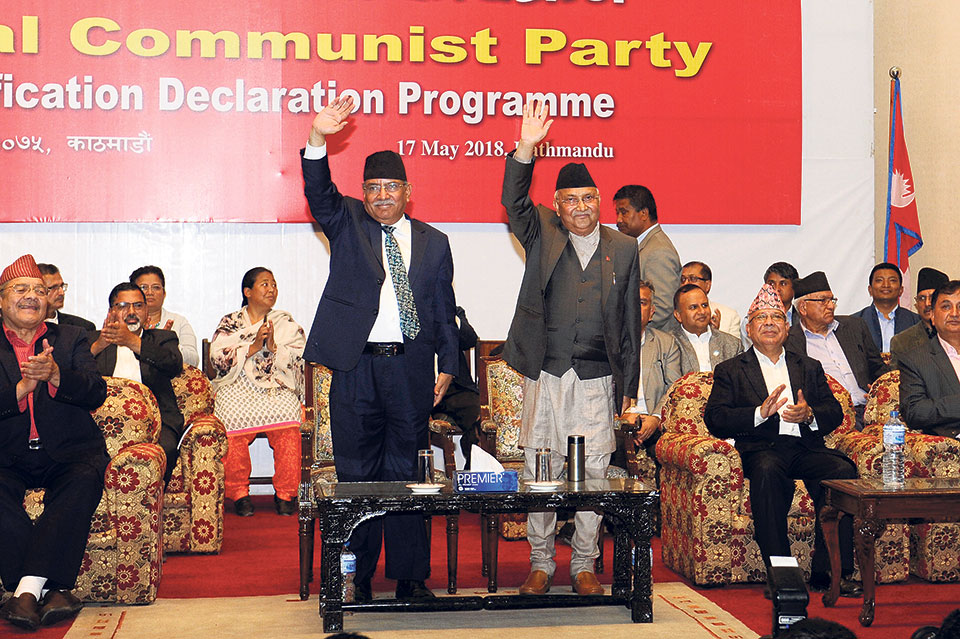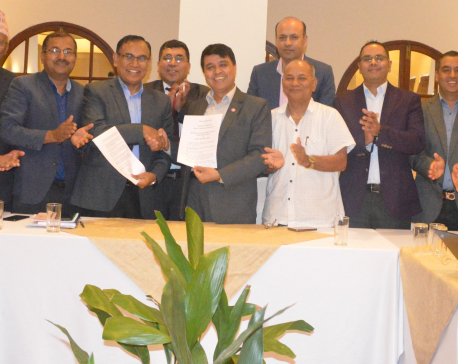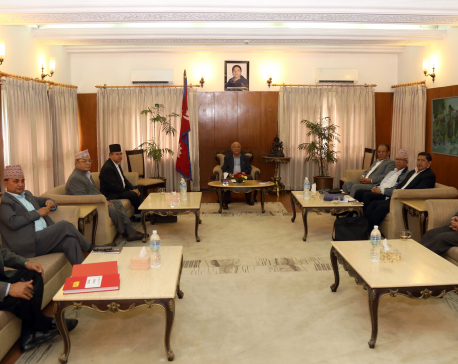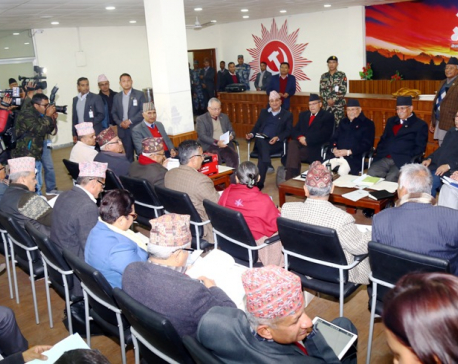
OR
Merger as NCP fails to erase past identities as UML, Maoist
Published On: May 18, 2019 06:00 AM NPT By: Republica | @RepublicaNepal

KATHMANDU, May 18: Failing to merge the committees and wings of the two former parties – UML and Maoist -- into singular entities even months after their unification pledges, the top leaders of the NCP have come up with a formula. The key positions would be allotted between the two sides from the central down to the local levels and nominations made in tandem to the leaderships of chapters across the country.
Just ahead of the completion of a year since the unification announcement of the erstwhile two parties, the NCP leaders agreed on two bases for nominating the leadership at the province, district and sister-wings levels.
First, they agreed on allocating around 60 percent of the seats to the former UML side and 40 to the former Maoists. Secondly, they agreed on a formula for nominating the chiefs and deputy chiefs of party committees from the two sides in tandem. For instance, if a province chief is from the former UML, the deputy chief would be from the former Maoist side and vice versa.
This was the most acceptable and pragmatic approach for the leaders to settle the leadership row and merge the committees into one and it has helped accommodate hundreds of party leaders and cadres.
But this approach has given continuity to the previous identities as Maoist or UML instead of throwing up just NCP members pure and simple.
NCP insiders say that although the top leaders have managed to resolve the issue technically for now, they have at the same time sowed the seeds of notional identities as former UML and former Maoist. All the more so as the chiefs and deputy chiefs in all the party committees are from alternate sides and they will try to strengthen their own factions in the long run.
“The leaders should instead have risen above their previous party affiliations, persuaded their comrades to assimilate into one another and brand themselves one and all as NCP members instead of giving continuity to their attachments to the already dissolved parties,” said Ajamber Rai Kangmang.
One of the reasons behind delay in the merger, according to informed party sources, was the interest of some top leaders in bringing certain individuals into the party's subordinate committees at any cost. In order to pick certain leaders for certain party responsibilities, the top leaders backtracked from the initial proposal to enforce a policy of 'one leader one position' . This policy would have meant that if a given leader is already in a government or party position, he/she shouldn't be given another such responsibility.
The top leaders have somehow managed the allocations between the former UML and former Maoists when they picked the provincial and district chiefs and deputy chiefs. However, the discord became publicly visible when the chiefs and deputy chiefs of 22 sister wings were announced on Thursday, the day marking a year since the unification announcement at the central level.
Former Maoist student wing chief Ranjit Tamang, who was nominated deputy chief of the student wing of the unified party, publicly challenged the decision, saying he wouldn't accept former UML student leader Ain Singh Mahar as his leader.
The leaders couldn't encourage party members from the two sides to assimilate into one another and discard their past baggage even as leaders from both parties know from experience the drawbacks of giving continuity to factional identities.
The UML is struggling to blur the lines between former UML and former ML led by Bamdev Gautam even 20 years after reunification of the two parties. Similar was the case with the Maoists as there are factions led by Narayankaji Shrestha and another faction led by Ram Bahadur Thapa, who returned to the mother party a few years back.
Similarly, the factional dispute between the Nepali Congress led by the Koiralas and the NC-Democratic led by Sher Bahadur Deuba still festers, nearly 15 years after reunification between the two Congress parties.
Congress leaders struggle to settle disputes in the sister wings and other committees as the senior leaders often support lower committee chiefs and deputy chiefs on the strength of past affiliations.
Left leaning analysts say the unification of the ruling NCP could collapse at any time if the top leaders don't work to assimilate their political, ideological and organizational strengths immediately. They say there has been delay in coming up with a common political ideology and in the acceptance of the leadership of a single individual in the party due to differences on the political, ideological and organizational fronts.
Given disagreement over the party's official ideology, the top leaders have been publicly disputing whether to recognize People's Multi-Party Democracy as pushed by the former UML or the People's Democracy of the former Maoist top brass .
“The party cannot remain united until and unless all agree on a single political ideology and leadership,” said former UML leader Radha Krishna Mainali adding, “From this perspective the NCP has not united in the real sense so far. So, it's political and ideological basis could collapse any time.”
You May Like This

Global IME and Janata Bank to go into merger
KATHMANDU, July 5: In line with the recent instruction of Nepal Rastra Bank Governor Chiranjivi Nepal, Global IME Bank and... Read More...

NCP top guns to consult taskforce before wrapping up merger process
KATHMANDU, Feb 19: Top leaders of the Nepal Communist Party (NCP) have agreed to take a final call on merger of... Read More...

NCP merger process stalled for months as task force fails to sort out internal rows
KATHMANDU, January 20: The merger of the lower committees, various departments and sister wings of the erstwhile CPN-UML and the CPN... Read More...
Just In
- KMC to organize a month-long skill fair from May 1
- Birgunj Metropolis collects over Rs 360 million in revenue
- NEPSE plunges below 2,000 points after one and a half months; daily turnover declines to Rs 2.10 billion
- AI Index Report-2024: AI still behind humans on complex tasks like competition-level mathematics
- Daiji-Jogbudha road construction at snail’s pace
- Govt fails to adopt podway technology despite its potential in Nepal
- Jhulaghat border crossing in Baitadi to remain closed from this evening
- Universities will be free from partisan interests: Education Minister


















Leave A Comment